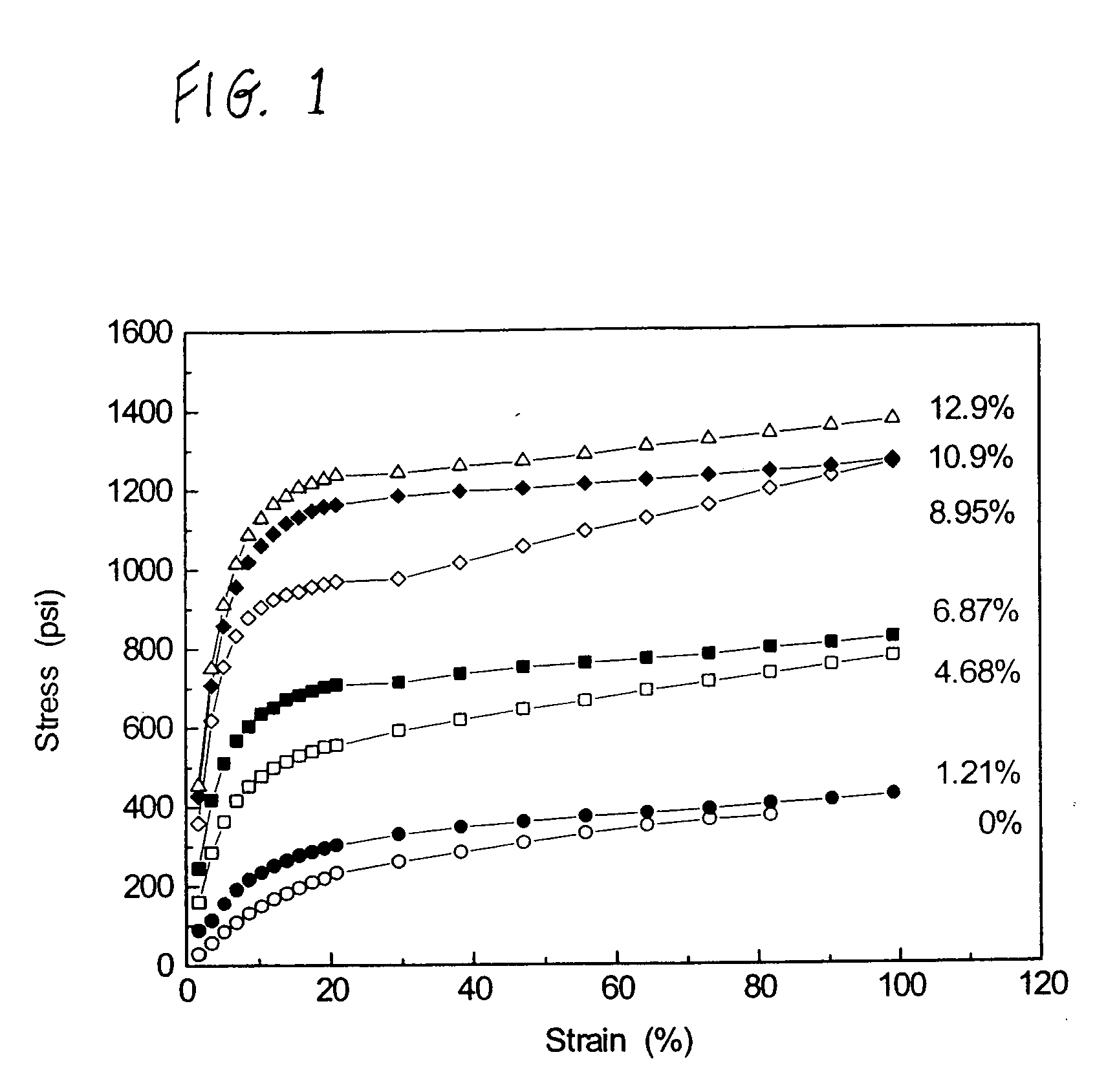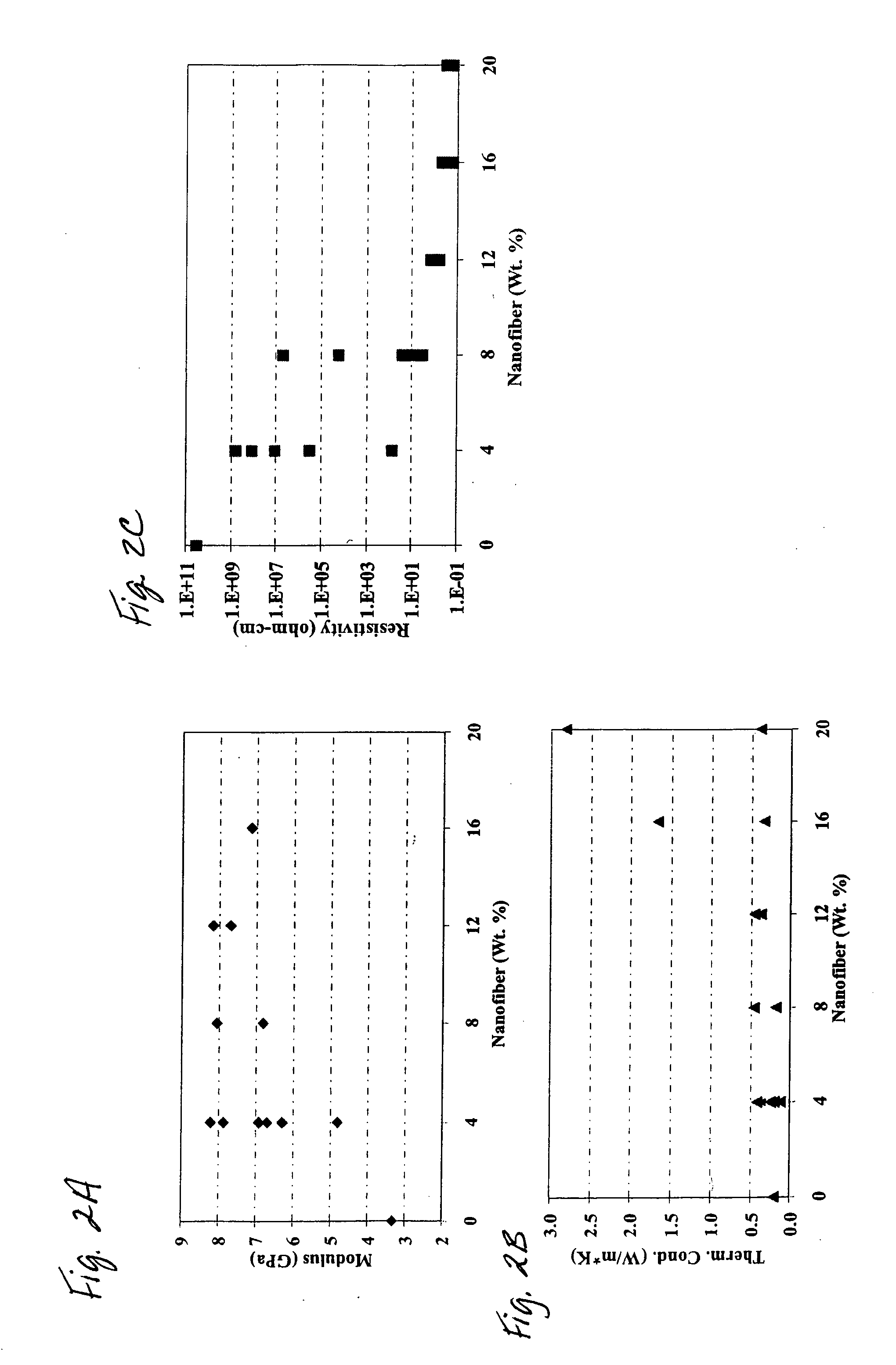Method of forming nanocomposite materials
a technology of nanocomposite materials and nanofibers, which is applied in the field of nanocomposite materials, can solve the problems of reducing the benefit of their properties, difficult to achieve uniform dispersion of materials in the polymer matrix, and breakage of carbon nanofibers, and achieves the effects of improving mechanical strength, dimensional stability, electrical and thermal conductivity, and abrasion resistan
- Summary
- Abstract
- Description
- Claims
- Application Information
AI Technical Summary
Benefits of technology
Problems solved by technology
Method used
Image
Examples
example 1
[0040] A nanocomposite material was prepared using various volume fractions (see FIG. 1) of vapor grown carbon nanofibers with a thermoplastic polyurethane polymer and tetrahydrofuran (THF). The solvent was removed by evaporation. FIG. 1 illustrates a stress-strain curve of the nanocomposite material as a function of the carbon nanofiber content. The curve illustrates that the tensile strength of the nanocomposite is increased from about 400 psi (no carbon nanofibers) to about 1400 psi when including 12.9% by volume of the carbon nanofibers.
example 2
[0041] A nanocomposite material was formed from polyurethane and carbon nanofibers in tetrahydrofuran (THF). The solvent was removed by evaporation. The abrasion resistance of the resulting nanocomposite was determined using a Plint friction test. A roller pin of 6mm×6 mm with a load of 550 g (5.4 Newton) was used for the test. The roller pin moved on the composite film with a stroke of 9 mm and a frequency of 2 Herz. The following Table 1 demonstrates that the film which contained no carbon nanofibers was torn in approximately 3 minutes, while the films which contained carbon nanofibers remained intact after 30 minutes of the test.
TABLE 1carbon nanotubesSample(wt %)Friction (N)CoefficientTime (min.)103.80.70˜3204.10.76>30316.63.60.67>30416.63.70.69>30528.82.30.43>30628.82.40.44>30
example 3
[0042] 6 grams of single-wall carbon nanotubes were obtained from Rice University and dispersed in a solvent comprising a mixture of 50% fuming sulfuric acid and 50% polyphosphoric acid in a Haake mixer at 180° C. for 30 minutes. 4 grams of a rigid-rod polymer poly(p-phenylene benzobisthiazole) was added to the mixture and mixed for one hour. The resulting solution mixture was transferred into an extrusion vessel and extruded into a fiber at 160° C. through a spinneret of 510 μm diameter. The fiber was coagulated in distilled water to remove the acids. After the fiber was thoroughly washed with watter, it was air dried. The dry fiber was also heat-treated under tension at 500° C. and 600° C., respectively. The fiber exhibited a diameter of 80 to 100 μm, a tensile strength of about 26 Kpsi, a Young's modulus of 1.8 Mpsi, and an electrical conductivity as high as 400 S / cm.
PUM
| Property | Measurement | Unit |
|---|---|---|
| Mechanical strength | aaaaa | aaaaa |
| Dimensional stability | aaaaa | aaaaa |
| Thermoplasticity | aaaaa | aaaaa |
Abstract
Description
Claims
Application Information
 Login to View More
Login to View More - R&D
- Intellectual Property
- Life Sciences
- Materials
- Tech Scout
- Unparalleled Data Quality
- Higher Quality Content
- 60% Fewer Hallucinations
Browse by: Latest US Patents, China's latest patents, Technical Efficacy Thesaurus, Application Domain, Technology Topic, Popular Technical Reports.
© 2025 PatSnap. All rights reserved.Legal|Privacy policy|Modern Slavery Act Transparency Statement|Sitemap|About US| Contact US: help@patsnap.com



